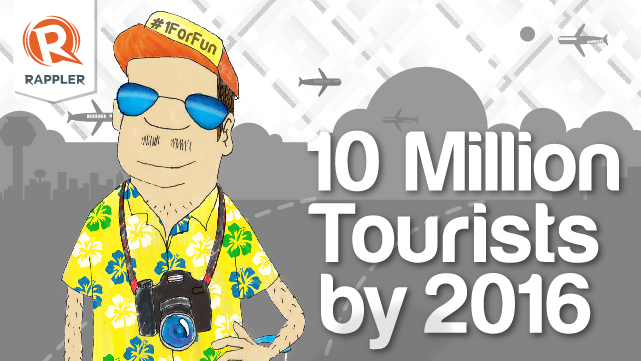SUMMARY
This is AI generated summarization, which may have errors. For context, always refer to the full article.

MANILA, Philippines – The government is set to review the targets for tourism this 2013 after the political clashes with neighbor countries and the 7.2 magnitude earthquake that recently hit Cebu and Bohol.
This review was announced by Tourism Undersecretary Daniel Corpus in an interview with reporters on the sidelines of the “Rising Stars of the Philippines” forum organized by AsianInvestor and FinanceAsia on Thursday, October 17.
Corpus said that the Tourism Department is already expecting only 5 million tourist arrivals in 2013, lower than the original target of 5.5 million.
“By end of this year, we will breach the 5 million. Still the highest in history,” he stressed.
The Aquino government aims to hit 10 million tourists by 2016. (INFOGRAPHIC: Is 10-M tourists goal possible?)
In January to July this 2013, the country had 2.8 million visitors, less than half of the original target.
In 2012, 4.2 million foreigners visited the country, up 9.07% from 3.9 million in 2011. The government attributed the increase to the country’s tourism campaign, “It’s more fun in the Philippines!“
Political, diplomatic woes
Corpus explained that the country’s political woes with Malaysia in the first quarter, along with a stained relations with Taiwan in May have significantly affected tourist arrivals.
The Philippines and Malaysia clashed in March over a territorial dispute on the island state of Sabah. For about a month, Malaysian authorities pursued scores of Filipino gunmen who landed in Sabah to resurrect long-dormant land claims.
On the other hand, Taiwan government issued a red travel advisory against the Philippines after a Taiwanese fisherman was shot by the Philippine coast guard.
“We started with some concerns, with Malaysia. That has affected the Malaysian market which was growing almost 20% last year, now its down to 3%,” Corpus noted.
Tourism arrivals from Taiwan dwindled significantly after a travel warning was issued by the Taiwanese government.
“It has resulted [in a] negative 33% growth rate ( for Taiwan). Target is to erase that 33% by end of this year,” he said.
A recent security issue — the clashes between the military and Moro National Liberation Front (MNLF) fighters in Zamboanga City in September — had no impact on tourist arrivals, Tourism Secretary Ramon Jimenez said in a briefing on September 17.
There were no booking cancellations then, stressing that the violence in Mindanao had “no immediate implications on tourism.”
Cancellations from foreign tourists, mostly Koreans and Chinese, have been noted after the 7.2 magnitude earthquake that recently hit Cebu and Bohol, both top travel destinations. (READ: Tourist cancellations hit after quake)
Good news
The tourism chief shared then that he is banking on the upcoming integration of the Asean economies by 2015 to sustain tourism arrivals growth in the country.
Officials are targeting to hit 8 million arrivals by 2015 and 10 million by 2016.
He also cited the increasing number of flights between the Philippines and Southeast Asian neighbors as one of the factors boosting the tourism industry’s performance. (INFOGRAPHIC: How PH budget airlines change the game)
The Philippine domestic airline industry has the highest budget carrier penetration rate in Southeast Asia.
Access to and from the Philippines, an archipelago of 7,100 islands, got a boost in July after the European Union (EU) allowed legacy carrier Philippine Airlines (PAL) to fly again to the group’s 28 member states.
This will open the country’s tourism industry to broader markets, Jimenez previously said.
The tourism department expects tourist arrivals from Europe to double to 600,000 within a year and a half from about 300,000 currently. Bulk of the arrivals would come from the United Kingdom and Germany as well as Eastern Europe, the agency said.
The EU lifted the ban on PAL, citing the Philippines’ efforts in addressing serious air safety concerns. (READ and WATCH: How Philippines got off EU’s aviation blacklist) – Rappler.com
Add a comment
How does this make you feel?
There are no comments yet. Add your comment to start the conversation.